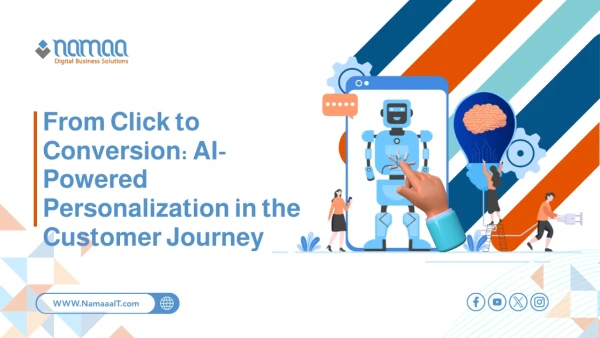Artificial Intelligence (AI): Definition, Components, and Applications
Artificial Intelligence (AI) is considered one of the most prominent technological advancements of the modern era. It enables machines and software to simulate human cognitive abilities such as learning, reasoning, and decision-making. Its applications span across various fields, from personal digital assistants to big data analysis. This article aims to provide an overview of AI, focusing on its definition, applications, and impact on different sectors.
What is Artificial Intelligence?
Artificial Intelligence (AI) is a branch of computer science that aims to create systems capable of simulating human intelligence, such as thinking, learning, decision-making, and problem-solving. AI relies on advanced technologies that allow machines to analyze data and adapt to new situations, making it a core component of digital era advancements.
The concept of AI began in the 1950s when scientist Alan Turing asked a revolutionary yet simple question: "Can machines think?" This was followed by rapid developments, from the creation of the first basic chess program to the emergence of complex algorithms found today in modern applications like voice assistants and recommendation systems.
AI has gone through phases of enthusiasm and setbacks. However, the last decade witnessed a surge in interest and applications due to the availability of Big Data and increased computing power. Today, AI is widely used in fields like healthcare, industry, education, and financial services. It has also become an integral part of everyday life through smartphones, modern vehicles, and websites.
Understanding the history and evolution of AI helps us appreciate its enormous potential and the ethical and technical challenges it presents. AI is not only about automating tasks but also about enhancing human capabilities and enabling more accurate decision-making across multiple fields.
Key Components of AI: Machine Learning and Neural Networks
AI is fundamentally built on core components, the most notable being Machine Learning (ML) and Artificial Neural Networks (ANNs).
Machine Learning is a subfield of AI that enables systems to learn from data and improve their performance without being explicitly programmed. The algorithmic model analyzes large datasets to detect patterns and relationships, then uses that knowledge to make decisions or predictions. In other words, the more data the system receives, the more accurate and predictive it becomes.
Artificial Neural Networks, inspired by the structure of the human brain, are used to develop systems that can understand complex information. These networks consist of layers of interconnected nodes (neurons) through which data passes and is adjusted based on the output results. Neural networks are widely used in fields like image recognition, voice analysis, and text processing. When combined with Deep Learning, these networks can handle more complex data and produce astonishingly accurate results.
These components are not just technical tools; they drive innovation across various industries. For instance, ML is used to improve search engines, while neural networks power voice assistants like Siri and Google Assistant. A solid understanding of these two elements provides clearer insight into how AI works and where it can be effectively applied.
AI vs. Machine Learning vs. Deep Learning
The terms AI, Machine Learning, and Deep Learning are often used interchangeably, though each has a distinct meaning and specific applications.
Artificial Intelligence is the broadest term and refers to any technique or system designed to mimic intelligent human behavior. This includes systems based on pre-programmed rules or those that learn and evolve over time. In essence, AI is the umbrella under which all technologies that simulate human intelligence fall.
Machine Learning is a subfield of AI focused on enabling systems to learn from data and improve performance without direct programming. ML systems rely on data analysis algorithms and can predict outcomes or classify information based on their learning. Common ML applications include spam filters, recommendation engines, and user behavior analysis.
Deep Learning is an advanced evolution of ML that relies on multi-layered neural networks. This type of learning allows systems to process massive and complex data like images, video, and audio with high accuracy. Deep learning is used in applications such as facial recognition, real-time translation, and autonomous vehicles.
Applications of AI in E-Commerce
E-commerce has witnessed massive development thanks to the integration of AI technologies, making shopping experiences more personalized and efficient. One of the most prominent AI applications in this field is recommendation systems, which analyze user behavior to suggest products and services that match their interests and preferences. For example, when a user views a certain product, the platform recommends similar items based on previous purchases and on-site interactions.
AI is also used to enhance customer experience through chatbots, which provide 24/7 instant support without human intervention. These systems can answer frequently asked questions, track orders, and offer suggestions—improving customer satisfaction while reducing operational costs.
Moreover, AI-powered data analytics tools offer deep insights into market trends and consumer behavior, allowing companies to make informed decisions regarding inventory, pricing, and marketing campaigns. AI is also used to detect online fraud by identifying suspicious behavioral patterns.
Thanks to these capabilities, e-commerce has become smarter and more responsive to customer needs. Companies that adopt AI gain a clear competitive advantage—improving user experience, increasing profits, and reducing costs. Thus, AI is an indispensable part of the future of digital commerce.
AI in Education: Enhancing the Learning Experience
The integration of AI in education has brought about a radical shift in teaching methods and learning approaches. Educators and students alike now benefit from smart tools that enhance the efficiency of the educational process. One of the most notable AI applications in education is adaptive learning systems, which analyze student performance and deliver personalized content that matches their level of understanding and learning speed. These systems help bridge knowledge gaps and provide each learner with a tailored educational experience.
AI is also used to automatically grade tests and evaluate assignments, saving teachers significant time and effort while reducing human error. Additionally, tools for translation, summarization, and speech-to-text recognition support students from diverse linguistic backgrounds, making education more inclusive and accessible.
AI can also analyze large-scale educational data to generate insights that help institutions improve curricula and enhance learning environments. For example, it can identify subjects or topics where students struggle, enabling timely adjustments by educators.
AI Applications in Cybersecurity
Cybersecurity is one of the fields that has greatly benefited from AI technologies, given the increasing challenges in combating complex cyber threats. AI-powered cybersecurity systems analyze massive volumes of data to detect abnormal patterns that could indicate potential breaches or suspicious activity. This real-time analytical capability is crucial for early detection of cyberattacks.
Machine learning algorithms are used to identify new and unknown threats—known as zero-day attacks—by predicting malicious software behavior before any damage occurs. These systems can also distinguish between normal and unusual user activities within networks, helping to combat internal threats as well.
Practical AI applications in this field include anti-phishing tools, advanced security software, and Security Information and Event Management (SIEM) systems, which collect and analyze events from multiple sources. Additionally, some smart systems can automatically take action to mitigate damage upon detecting a threat, such as isolating an infected device or temporarily disabling a suspicious account.
AI in cybersecurity is not limited to defense; it also extends to post-incident analysis and generating detailed reports to prevent future attacks. Thanks to these capabilities, AI has become the first line of defense against sophisticated and evolving digital threats.
Artificial Intelligence in Machine Translation and Natural Language Development
Machine translation and the development of Natural Language Processing (NLP) have witnessed remarkable advancements thanks to artificial intelligence, making language translation more accurate and seamless than ever before. These systems rely on deep learning techniques and neural networks to understand linguistic context precisely, which marks a significant improvement compared to traditional rule-based translation methods.
Modern translation systems like Google Translate and DeepL use advanced language models trained on millions of previously translated texts, allowing them to produce natural, human-like translations. Translation is no longer about simply replacing words, but about understanding context and intended meaning, greatly enhancing the quality of translated content.
Artificial intelligence is also used in developing smart writing tools, grammar checkers, and text analysis systems, helping writers and translators automatically improve their language output. Additionally, it benefits people with special needs through tools that convert text to speech or vice versa, enhancing the inclusivity of technology for all users.
This advancement not only benefits individuals but also extends to organizations and companies dealing with clients from diverse cultural backgrounds. Thanks to AI technologies, language is now a barrier that can be easily overcome, boosting communication and understanding on a global scale.
learn about: Types of Artificial Intelligence
AI Applications in Entertainment and Gaming
Artificial intelligence has radically transformed the way we interact with entertainment, especially in the field of electronic gaming, where it has become an integral part of the modern gaming experience. Many games today use AI to create intelligent characters that behave realistically and interact dynamically with players, making the gameplay more challenging and exciting. AI is no longer limited to programming repetitive enemies but can now learn from player behavior and adapt accordingly.
In film and digital content production, AI is used to analyze viewer preferences, helping platforms like Netflix and YouTube offer personalized recommendations based on individual interests. AI technologies also enhance video quality, such as by automatically colorizing old footage or improving image and sound resolution.
AI is also used to automatically generate new content, such as music creation, script writing, or even designing 3D scenes using deep learning techniques. This allows content creators to produce high-quality work faster and at lower costs.
AI also paves the way for interactive entertainment experiences like virtual and augmented reality, where systems interact intelligently and realistically with users. Thanks to these advances, the entertainment industry has become more creative and diverse, combining AI and art to deliver unique experiences.
Artificial Intelligence in Big Data Analysis
Big Data analysis is one of the fields that benefit most from AI technologies, especially as the volume of digital data generated daily by smart devices, apps, and websites continues to grow. AI is used to quickly and accurately process this vast amount of data, discovering patterns and relationships within complex data sets—something that would be difficult for humans to do manually.
AI tools, such as machine learning algorithms, are used to analyze customer data, predict market trends, and identify recurring behaviors. For example, a smart system can analyze online shopping data to identify the most attractive products to users, helping businesses adjust marketing strategies or develop better products.
AI is also used in medical data analysis to detect potential chronic illnesses before symptoms appear, and in transportation to improve traffic flow by predicting road incidents. Its real-time processing capability allows decisions to be made swiftly, based on accurate and updated information.
AI not only accelerates the analysis process but also makes it more accurate and effective, enhancing organizations' ability to compete and grow. Therefore, AI-powered Big Data analysis has become a vital strategic tool across various industries.
AI Applications in Finance and Banking
Artificial intelligence is revolutionizing the finance and banking sector, enhancing operational efficiency, improving customer experience, and delivering more accurate and faster financial services. One of its major applications is predicting market behavior, where algorithms analyze economic data and stock prices to make accurate forecasts that help investors make better decisions.
AI also plays a key role in financial risk management, allowing institutions to evaluate customer creditworthiness using detailed analysis rather than relying solely on traditional criteria. This helps reduce fraud and minimize bad loan losses.
Many banks now rely on intelligent chatbots for customer service, offering 24/7 support without human intervention. Machine learning is also used to analyze customer behavior and offer tailored financial products and services.
In fraud detection, financial institutions use advanced AI systems to instantly detect suspicious transactions by comparing ongoing activities with previous behavioral patterns to spot anomalies or potential threats.
Thanks to these technologies, financial operations are now more secure, fast, and accurate, giving customers greater confidence in digital banking. In this context, AI is not just a supporting tool but a cornerstone of the future of financial services.
AI Applications in Digital Marketing
Artificial intelligence has become a key player in the digital marketing world, used to analyze user data, personalize content, and optimize marketing campaign performance. By analyzing visitor behavior on websites and apps, AI can accurately identify preferences and interests, enabling more effective targeted advertising.
One of the most notable applications is recommendation systems, which suggest products or services based on past activities—like what you see on Amazon and Netflix. This kind of personalization increases conversion rates and enhances the overall user experience. AI is also used in Search Engine Optimization (SEO) by analyzing keywords and search behavior to improve site rankings on Google.
In paid advertising, AI helps identify the optimal target audience and the best time and place to show ads. Machine learning algorithms also enable automated A/B testing to improve campaign performance in real time.
Sentiment analysis tools allow marketers to understand how audiences feel about content or a brand, enabling them to adjust strategies based on market sentiment. AI not only boosts marketing efficiency but also provides precision and adaptability in responding to market changes.
AI Applications in Supply Chain Management
Supply chain management is one of the fields that require speed and accuracy in decision-making, and this is where AI plays a crucial role in enhancing efficiency and reducing errors. By analyzing real-time data, AI can accurately forecast product demand, aiding in production planning and reducing waste or excess inventory.
AI technologies are also used to track shipments and monitor delivery operations, analyzing location and logistical data to provide instant solutions when delays or issues arise. They are also used to predict equipment malfunctions and schedule maintenance at optimal times, preventing sudden production halts.
Financially, AI can analyze operational costs and compare supplier performance, helping businesses choose more efficient and profitable partners. Algorithms can also optimize distribution routes and identify faster, more cost-effective ways to transport goods.
In supplier relationship management, AI is used to analyze interactions, predict supply issues, and negotiate better terms based on past performance data. This predictive and analytical capability ensures a more flexible and responsive supply chain.
Thanks to AI, supply chain management is no longer a traditional coordination process but has become a smart system that quickly adapts to changes and enhances companies' competitiveness in global markets.
Conclusion
✅ AI in education improves learning efficiency by up to 30%: According to EdTech reports, AI-powered adaptive learning systems can improve student outcomes by up to 30% compared to traditional teaching methods.
✅ 80% of financial institutions rely on AI for fraud detection: According to Business Insider, over 80% of major banks use AI systems for early detection of suspicious activity and financial transaction fraud.
✅ AI boosts digital marketing efficiency by up to 35%: A study by Salesforce revealed that companies using AI tools in digital marketing see an increase in engagement and sales by up to 35%.
✅ AI-powered big data analysis reduces decision-making time by 70%: According to IBM, using AI in data analysis can accelerate decision-making by up to 70% thanks to real-time processing.
✅ AI in supply chains cuts costs by 15%: A report by McKinsey indicated that companies implementing AI in supply chain management experience a reduction in operational costs by approximately 15%.

.webp)



.webp)



